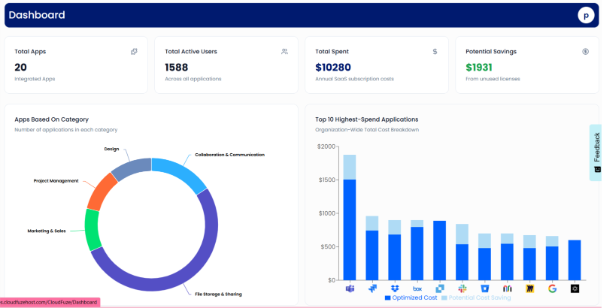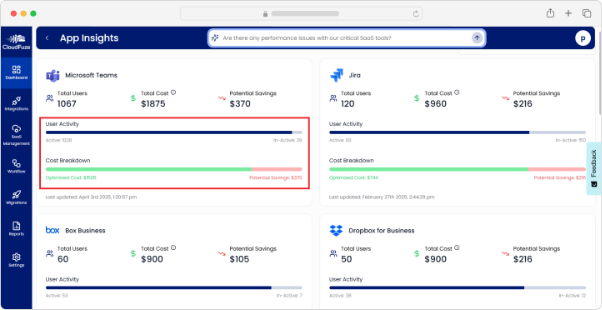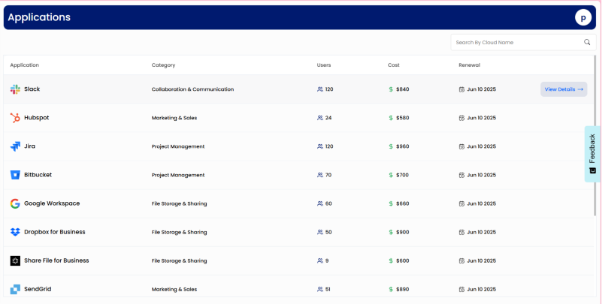5 Steps for Successful SaaS License Management
As your business grows, the number of SaaS tools that your organizations use also obviously increases. While SaaS products are easy to use, managing hundreds of these tools can be confusing.
If you don’t have a proper SaaS license management tool & strategy, you could find yourself overspending on unused subscriptions, missing renewal deadlines, or facing penalties.
At CloudFuze, we offer you the right SaaS management software that takes control of your SaaS licenses, reduces hidden subscription costs, and ensures your tools are fully optimized for your business needs.
In this post, you’ll learn how to successfully manage your SaaS licenses and how CloudFuze Manage can simplify this process for your enterprise.
What is SaaS License Management?
SaaS license management refers to the process of overseeing your software subscriptions that exactly align with your organization’s needs. It involves monitoring SaaS app usage, governing license agreements, and adjusting subscriptions when your business requirements change. The types of SaaS licenses are represented in the table below.
| Type of SaaS License | Explanation |
|---|---|
| Per-User | You pay only an amount for an individual user (“seat”) who gets access. |
| Usage-Based | User-based licensing directly reflects how much you use the software (e.g., data, transactions, and API calls). |
| Tiered Pricing | You can choose from pre-paid plans (e.g., Basic, Standard, or Premium) that offer different features, limits, and support levels. |
| Feature-Based | You pay based on the specific features /modules you subscribe to. |
| Flat-Rate Pricing | Pay a single, fixed recurring fee for full software access, often with unlimited users/features. |
| Freemium | You get a basic version for free, and you must pay extra to upgrade to avail full features. |
| Concurrent User | Here, you pay for the maximum number of users who can access the software simultaneously, not for each named user who uses the tool. |
| Enterprise | You enter into highly customized agreements designed for large organizations, which cover personalized pricing, features & support. |
Benefits of SaaS License Management
The benefits of SaaS Licensing management are:
- You can actively manage your SaaS licenses, which helps you eliminate unused subscriptions and reduce unnecessary costs.
- Monitor your licenses to align with industry standards (SOC 2 Type 2 & GDPR), preventing penalties and legal issues.
- By understanding your software usage, you can maximize the value of the tools your teams use.
- As your company grows, you must scale your SaaS tools. Effective license management makes this process smoother.
- Managing access to software ensures that only access-approved employees are using the tools, reducing SaaS security risks & threats.
5 Steps for Successful SaaS License Management
You can take control of your SaaS license management by following these five actionable steps:
Step one: Try to Understand Your Enterprise’s SaaS Licensing Needs
Before purchasing any software, you need to have a clear idea of your company’s needs.
- Identify which departments need specific SaaS tools. For example, sales teams may need a CRM platform, while your finance team may require accounting software.
- Make sure you only purchase software that is necessary for your business operations. So, you can avoid paying for extra features or user licenses that you don’t need.
- Also, choose tools that can grow with your business. This will save you from switching software as your organization expands.
Step Two: Always Centralize Your SaaS Purchases
Managing SaaS tools can get messy when different departments buy software independently. Therefore,
- Designate one team or individual to handle all SaaS purchases and renewals. This will ensure all software decisions are made strategically.
- Establish transparent processes for requesting and evaluating new software purchases. Also, make sure all tools go through the same approval workflow.
- You can keep a common inventory of all the software your company uses. This will help you avoid duplicate subscriptions and be aware of renewal dates and costs.
Step Three: Automate Your License Monitoring
Tracking SaaS licenses manually can be a challenging task. Automating this process with the right software tools can save you time and reduce the risk of errors. You can do this with ease by:
- Investing in software that helps you track the status of your SaaS licenses, including renewals, usage, and compliance.
- Keeping an eye on software usage to avoid paying for unused licenses. If certain software licenses aren’t being used, you can eliminate them to save costs.
- Automating your license tracking to stay compliant with vendor terms, avoiding penalties & legal issues.
With our leading SaaS management platform, you can automate your license monitoring to stay audit-ready.
Step Four: Properly Review & Optimize your Licenses
SaaS license management is a continuous process. So,
- Schedule regular reviews of your SaaS subscriptions, ideally quarterly or biannually. This will help you identify which tools are still necessary and which can be eliminated.
- Adjust for your company’s changing needs. For example, a department may no longer need access to a specific tool, or your team might require more users.
- If you find you’re paying for extra features or a higher-tier plan than you need, consider downgrading or switching to a more cost-effective option.
Using CloudFuze Manage’s all-in-one dashboard, you can easily review and eliminate unused licenses.
Step Five: Often Train Your Employees on SaaS Usage
Your employees are the people who will use the software daily, so it’s crucial to make sure that they understand the tools and how to use them responsibly.
- Offer training sessions to ensure employees understand how to use each tool effectively and get the most out of the software.
- Develop clear internal policies for software usage, such as prohibiting account sharing or exceeding license limits.
- Always help employees to understand the importance of compliance and staying within the terms of the software licenses.
Our proven SaaS Management solution provides details about app usage activity or trends to help you make insightful decisions about user training.
Easily Handle Your SaaS License Management with CloudFuze Manage
Our SaaS management tool simplifies your SaaS license management by offering an all-in-one solution for tracking software usage, automating onboarding and offboarding, confirming SaaS security, and optimizing license allocation. With CloudFuze Manage, you can:
- Connect and manage all of your SaaS subscriptions in one place.

- Automatically track license usage and renewals, thus saving time and avoiding errors. Use the “Potential Savings” widget to identify inactive users across your SaaS apps. It shows active vs. inactive users in your organization.

- The cost breakdown feature estimates how much you can save by removing unused licenses.

- Identify underused software licenses and optimize your subscription plans to save cost by 20-30%.
- As your business grows, our SaaS License management tool allows you to scale your SaaS tools without overspending or losing track of licenses.
Final Thoughts
Overseeing your SaaS license management is essential for the long-term success of your business. By following the above 5 steps, you can optimize software usage, reduce hidden subscription costs, and stay compliant with vendor agreements.
With CloudFuze Manage, you can take the hassle out of SaaS license management, enabling your business to scale efficiently with low cost.
Contact us for a free demo today!
FAQs
1. What are the common signs indicating SaaS licenses are underused?
Low or no user activity, duplicate subscriptions, unused licenses after project completion, employees lacking training, and SaaS management reports showing inactive or rarely accessed accounts indicate underused licenses.
2. How often should I conduct SaaS license audits for optimal cost savings?
Conduct SaaS license audits quarterly or biannually for optimal savings. Fast-growing companies or those with frequent software changes may benefit from monthly reviews to catch unused licenses and ensure compliance.
3. Can CloudFuze integrate with all the SaaS tools my company uses?
CloudFuze integrates with 40+ major SaaS and cloud platforms. For less common or custom tools, contact CloudFuze to explore integration options or custom solutions.




Leave A Comment